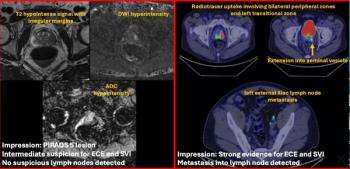
Diasonics plans VST sales promotion
Diasonics will expand advertising and direct-mail promotion programsduring the latter half of this year in support of its VST high-endradiology ultrasound scanner. The firm brought over 100 physiciansto San Francisco last Sunday for an introductory
Diasonics will expand advertising and direct-mail promotion programsduring the latter half of this year in support of its VST high-endradiology ultrasound scanner. The firm brought over 100 physiciansto San Francisco last Sunday for an introductory demonstrationof its VST Masters Series upgrade (SCAN 6/2/93).
Shipments of the upgrade are scheduled to commence in the thirdquarter of this year. A road show to tout the technology is plannedfor September, according to Bruce Moore, Diasonics Ultrasoundpresident and CEO.
Trimmer operations and a focused worldwide ultrasound saleseffort should help Diasonics Ultrasound become profitable in atight ultrasound market, Moore said. The Milpitas, CA, vendorreduced operating costs significantly over the past year, loweringits break-even sales volume.
"We have taken much expense out of the business,"he told SCAN. "This (upgrade) proves that we can offer innovationsyear in and year out with a cost structure that allows us to makemoney at a lower volume than our competitors."
Upon shareholder approval at Diasonics' September annual meeting,ultrasound imaging will separate from both the profitable OECDiasonics speciality x-ray business and an emerging program tocommercialize ultrasound tissue ablation technology, labeled focalsurgery (SCAN 2/24/93).
As a separate company, Diasonics Ultrasound will be betterpositioned to coordinate ultrasound sales and marketing globally,including the efforts of Diasonics' Sonotron and Vingmed Soundsubsidiaries in Europe, Moore said. As president of the currentultrasound division of Diasonics, Moore is responsible only forthe domestic ultrasound business, which involves largely radiologysales of Spectra VST systems.
"The international piece is a separate organization. Vingmedis separate also. We have three ultrasound organizations underone company," he said. "The new company will approachthe ultrasound market on a worldwide basis and look at radiology,cardiac and vascular applications."
The first Spectra scanner was introduced in 1989. Althoughthe Spectra name was dropped with this month's VST upgrade, allof the approximately 1000 Spectra systems installed worldwidecan be upgraded to the latest VST technology. About 300 VST systemshave been installed in the U.S. and another 100 internationally--eitheras new systems or upgrades--since the technology's introductionlast year (SCAN 4/8/92). Diasonics' entire ultrasound installedbase amounts to about 7500 units.
VST Master Series is part of a planned schedule of upgradesand not a reaction to upgrades provided by competitors, Mooresaid. The company must convince customers that it has the wherewithalto maintain a constant flow of upgrades.
"Our strategy for winning in the marketplace is to providesignificant innovations every year and to do this consistently.In that way, we will maintain our credibility and regain our reputationas an innovator, which we had in the early '80s," he said."This is a very competitive market. People want systems thatare at the state of the art not just the day they buy them, butfor five years after that."
Diasonics introduced three new transducers based on its MatchedImpedance technology:
- a 5-MHz vascular transducer;
- a 5-MHz transducer for abdominal and obstetric imaging;and
- a 7-MHz transducer for endovaginal and endorectal scanning.
These three probes have been added to the 3.5-MHz abdominaland 10-MHz small-parts Matched Impedance transducers originallyoffered with VST last year. Diasonics developed and manufacturesthese transducers itself. The Matched Impedance technology usescomposite ceramic and epoxy materials that reduce ultrasound reverberationsand clear up near-field haze.
While the recent upgrade improved the performance of VST'sbasic confocal gray-scale imaging technology, one feature, "ultrasoundangiography," expands applications by providing new typesof diagnostic information. Ultrasound angiography provides a nonquantitativeindication of blood flow volume through use of color-flow Doppler.It also allows for the visualization of smaller, low-flow vessels,he said.
"Traditional color has shown both velocity and direction.With ultrasound angiography, we have increased our sensitivitytenfold, allowing (users) to visualize the volume of flow as theywould in angiography," Moore said. "This offers essentiallya brand-new imaging mode that provides ultrasensitive road mappingof vessels."
While parts of the Master Series upgrade, such as a redesignedkeyboard, will be standard revisions in the VST product, bothultrasound angiography and patient-specific imaging will be offeredas system options, he said.
Patient-specific imaging allows the ultrasonographer to changeparameters for optimized scanning of light, average and heavypatients without changing the transducer.
BRIEFLY NOTED:
- Two agreements were signed this month between major multimodalityimaging vendors and laser printer suppliers. Agfa signed a nationalservice agreement with Philips Medical Systems North America forinstallation and warranty service of Matrix Compact L laser printersand Matrix Image Net digital networking centers sold by PMSNA.
Siemens and Kodak formalized their previous understanding tocooperate in marketing, sales and service of the Kodak Ektascan2180 laser printer. The two medical imaging vendors will sharetechnical information to facilitate connections between equipmentbuilt by each company.
Newsletter
Stay at the forefront of radiology with the Diagnostic Imaging newsletter, delivering the latest news, clinical insights, and imaging advancements for today’s radiologists.




























